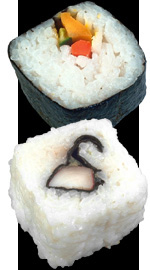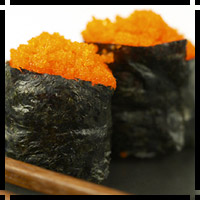 |
Japanese Cuisine
Roll Out The Sushi: Japanese Cuisine
Offers a World of Exciting Flavors
Essence by Jonell Nash
 Sushi,
once an exotic eat, seems to be everywhere these days.
The bite-size bundles of delicately vinegared rice along
with fish and/or vegetables all wrapped in seaweed are
a superb blend of tastes and textures. The wild surge
in its popularity is also linked to its gorgeous looks
and its healthfulness. A surprising discovery is how easily
you can learn to roll your own sushi and to make other
Japanese dishes at home. Boredom with the same ole thing
will fly out the window when you put these fresh flavors
and striking combinations on your dinner or party table. Sushi,
once an exotic eat, seems to be everywhere these days.
The bite-size bundles of delicately vinegared rice along
with fish and/or vegetables all wrapped in seaweed are
a superb blend of tastes and textures. The wild surge
in its popularity is also linked to its gorgeous looks
and its healthfulness. A surprising discovery is how easily
you can learn to roll your own sushi and to make other
Japanese dishes at home. Boredom with the same ole thing
will fly out the window when you put these fresh flavors
and striking combinations on your dinner or party table.
THE RAW DEAL
"Eat raw fish? You're crazy? That was how Maranda
Moses' girlfriends responded last summer when she suggested
eating at a sushi bar. But they eventually agreed, and
now sushi has become their favorite indulgence. "And
that same bar is now our regular hangout," says Moses,
a freelance writer in Montreal.
SUSHI SPEAK
Here's a menu translator of the four categories of sushi:
Maki is the common paper-thin layer of toasted seaweed
topped with rice and stuffed with thin pieces of raw or
cooked fish, shellfish, egg or vegetables and shaped into
a roll. The rolls are cut into slices.
Temaki is similar to maki but is cone-shaped, uncut and
eaten by hand.
Nigiri is best known; it consists of a piece of fish or
seafood placed on an oblong-shaped finger of vinegared
rice that's seasoned with a dab of horseradish. The fish
is generally raw, however, shellfish are sometimes cooked.
Sashimi is an assortment of sliced raw fish, such as tuna
served on a platter with garnishes.
All are eaten with distinct condiments, including gari
(pickled sliced ginger), wasabi (Japanese horseradish)
and shoyu (soy sauce).
DINING DO'S AND DON'T'S
Here are hints for good manners from a global-marketing
specialist, Kathryn D. Leary, who trains executives in
cross-cultural etiquette.
DO:
* Dip nigiri sushi into soy sauce on the fish side only.
It's a mistake (and considered bad manners) to dip the
rice side.
* Eat a piece of sushi in just one bite.
* Set the tips of your chopsticks on the chopstick rest
when not in use.
* Mix a little wasabi into the soy sauce for dipping.
(Be careful not to eat wasabi by itself.)
* Remember, when drinking sake, that you should always
fill everyone else's cup first, then your own.
DON'T:
* Spear your food with chopsticks.
* Pile ginger on the sushi. Gari, the pickled-ginger slices
that accompany sushi, are for cleansing your palate between
bites. Eating and cleansing at the same time undermines
the purpose.
* Pass food directly from your chopsticks to someone else's
chopsticks; pass the tray.
A HEALTHFUL CHOICE
Easy on the heart and waistline, the emphasis in Japanese
cooking is on seafood, rice and vegetables, rather than
high-cholesterol red meat and dairy foods. It's not incidental
that many of the classic ingredients like tofu, bean sprouts,
buckwheat noodles and seaweed are commonly found in health-food
stores.
EXPLORING ASIAN MARK
Asian groceries and markets appear in neighborhoods all
over the nation. The sights, sounds and smells transport
you to other lands where you can find tasty ingredients
for dinner at great prices.
1. Ginger--This knobby root is juiced, minced, grated
or sliced to add aroma and spicy bite to dishes. It's
also pickled to make gari, the sushi garnish.
2. Shiso leaves--This serrated, deep green, heart-shaped
herb tastes of cinnamon and ginger. The leaves are often
sold in small stacks tied with string; add to soups or
deep-fry in tempura.
3. Radish sprouts--Select sprouts with buds attached for
a peppery accent to salads or as a garnish.
4. Mung-bean sprouts--Toss whole into dishes to add a
light, crunchy texture. Limit cooking time to less than
a minute.
5. Wakame--This deep-green leafy kelp comes in fresh and
dried forms. Add it to miso soup and vinegared salads
for chewy texture and sea-brine flavor.
6. Bok choy--Also called Chinese cabbage, it's tender,
cooks quickly and is good when stir-fried or chopped and
added to soups.
7. Soba noodles--Made from buckwheat, these somewhat chewy
noodles have a nutty flavor. Add them to soups and stir-fries;
top with shrimp or tofu.
8. Nori--This processed seaweed looks like thin sheets
of rough black paper and is the common wrap for sushi.
9. Sushi rice--The stubby plump grains are mixed with
sugar and rice vinegar to form the base of all types of
sushi.
10. Asian eggplant--This mild-flavored seedless version
goes with an array of meat, egg, curry and grilled dishes,
or deep-fry it in tempura.
11. Lotus root--When cut, this mildly sweet root of the
lotus flower resembles Swiss cheese. Add to salads, stir-fry
or deep-fry in tempura. |
|
|
